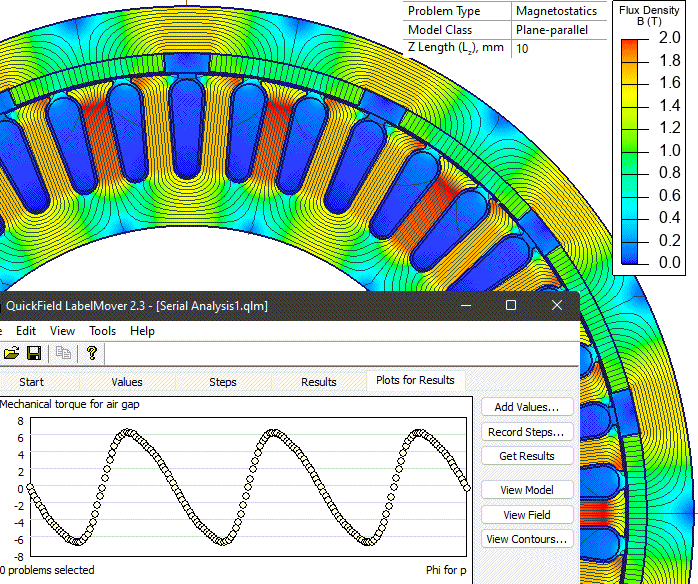BLDC motor slots skewing
QuickField simulation example
Тo reduce the cogging torque and improve the back EMF shape in the brushless permanent magnet motor the stator slots are skewed. We replace the 3D model with a set of 2D model-slices. The no-load mode is simulated. Motor dimensions are taken from this paper [1].
Problem Type
Plane-parallel problem of DC magnetics.
Geometry
Motor z-length is 40 mm.
Given
Rotational speed 170 rpm.
Number of turns per slot is 18.
Permanent magnet coercive force 979 kA/m, residual flux density 1.29 T.
Task
Calculate the cogging torque and back EMF in no-load mode.
Solution
We represent a skewed stator as a set of straight stators shifted by a fixed angle. Each section is modelled in a separate problem.
In QuickField we simulate a series of problems with different rotor positions. Torque and the flux linkage are calculated. The flux linkage is calculated for each phase: ΨA+, ΨA-, ΨB+, ΨB-, ΨC+, ΨC-.
LabelMover parameterization tool is used to automate calculations. It automatically modifies the geometry model, solves the problems and extracts the result. We repeat the procedure for each of the straight-stator models.
Further steps are carried outside of QuickField:
- We sum up torques and the flux linkages of each straight-stator model. This gives us the torque and flux linkage of the skewed stator.
- We find the flux linkage of the coil by subtracting the slots' flux linkages: ΨA = ΨA+ - ΨA-
- We compute voltage by derivating flux vs. angle dependency:
To measure the cogging harmonics accurately the Δ(angle) value should be small. We take it to be 1/60 of the stator tooth pitch angle.
Results

Skewing allows to reduce cogging torque drastically. In the plot you can see torques from straight stators T1, T2, T3, T4 and a torque in a skewed stator (T1 + T2 + T3 + T4)
Flux linkage vs. angle dependency has a triangle shape that results in a trapezoidal shape of back EMF.
Reference:
[1] Jagiela, Mariusz & Mendrela, Ernest & Gottipati, P.. (2012). Investigation on a choice of stator slot skew angle in brushless PM machines. Electrical Engineering. 95. 10.1007/s00202-012-0252-8.
- Download simulation files (files may be viewed using any QuickField Edition).